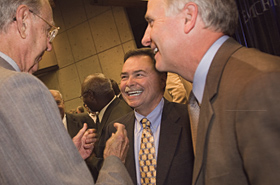Autumn 2007

Jack Kearse
No Place Like Home
The School of Medicine moves into its first-ever dedicated space
By Mary J. Loftus
Stately and elegant, the new School of Medicine building seamlessly connects the historic Anatomy and Physiology buildings as if it had always been there, waiting to become visible. But the medical education that will take place within its walls is decidedly twenty-first century.
This fall, medical students and faculty alike returned to a new $58 million, 162,000-square-foot building on Clifton Road—the first structure on campus to bear the school’s name. The new central wing sits between the renovated older buildings, which date back to 1917, retaining their signature pink marble exterior and red tile roofs. The complex embraces a courtyard filled with native plants and trees that faces Emory Hospital.

Welcome: Emory’s new Executive Vice President for Health Affairs Fred Sanfilippo (center) enjoys a warm greeting from Chief Medical Administrator Emeritus Dan Barker (left) and President James Wagner after Sanfilippo’s first address to the community.
Ann Borden
“It’s great, especially the new lecture halls. And all of our classes are here, including the pathology labs, which used to be at Grady, so we don’t have to go off campus,” said second-year medical student Sara Gravelin, as she ate lunch in one of the medical school’s sunlit nooks. “Last year I would study at the School of Public Health, and I started to head over there again until I thought, ‘Oh wait, I can study in our own building!’ ”
The School of Medicine building makes possible a 15 percent increase in the size of the entering class, now totaling 133. A severe shortage of U.S. physicians is projected by the time the students graduate in 2011. This class also will be the first to complete its entire medical education with a revamped curriculum.
Several years in the making, the new curriculum emphasizes active learning to create physicians who are passionate about making a difference and who appreciate the complex issues surrounding patients, families, and communities. The building was designed in tandem with the curriculum, to emphasize the fundamentals of science within clinical settings and immerse students in clinical experiences from week one. “This innovative curriculum integrates basic and clinical sciences, allows students to acquire experience and skills through interaction with real and simulated patients, and presents medical scenarios,” says Dean Thomas Lawley. “The new building is already vibrating with the excitement of students and faculty alike as they engage all the state-of-the-art elements for learning available to them.”